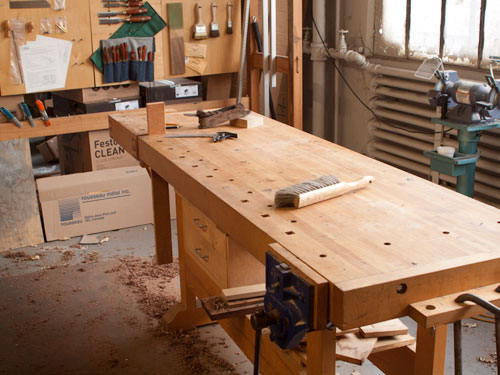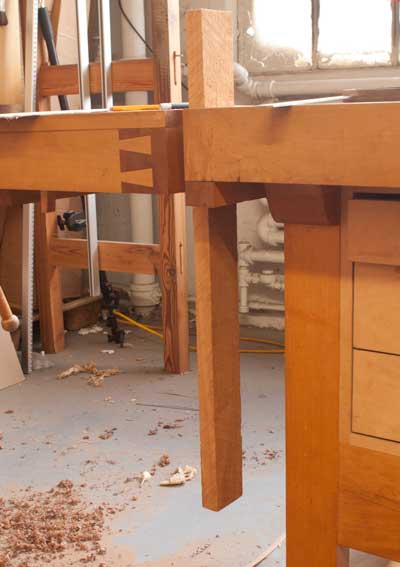 I built the workbench in the picture in the late 1980's. It serves me well and I have very few complaints. The design is basically the Frank Klausz bench that is detailed in Scott Landis' landmark The Workbench Book. The major changes I made were making it left-handed, and using a quick release vise as the front vise. I built the workbench in the picture in the late 1980's. It serves me well and I have very few complaints. The design is basically the Frank Klausz bench that is detailed in Scott Landis' landmark The Workbench Book. The major changes I made were making it left-handed, and using a quick release vise as the front vise.
In the past few years there has been an explosion in workbench design and fitting. However most modern workbenches don't use a traditional tail vise, they usually use some version of a face vise just at the end of the workbench, or some sort of wagon vise. Lee Valley just introduced a mini-wagon vise. While these approaches allow you to clamp lots of long things and are reasonably versatile I don't think they are nearly as useful as a traditional "L" shaped shoulder or tail vise. (Lee valley also has some funky quick-release tail vise hardware).
The main reason why a traditional tail vise is so darn useful is because of the unobstructed gap you get in the front of your bench. this gives you the perfect way to solidly clamp chair legs, or any long part that needs to be held while you work on it from one end. You also have space on both sides of the work for tools.
In my case the tail vise also has dog holes so I can easily clamp boards over seven feet long, longer than my bench, and have them supported all along the underside, except for a small gap. With a end mounted face vise you just don't get that kind of support. Wagon vises do give you that kind of support but without allowing you to extend the clamping length past the length of the bench.
Another use for a tail vise is something I saw recently and adopted immediately. Tage Frid, an early writer for Fine Woodworking Magazine saws his blind dovetail tails by holding them diagonally in the tail vise. I tried this and it means I don't have to crouch and saw up, and I can see both the inside face and the end grain as I am sawing. 
My tail vise was made completely out of wood, the mechanism isn't perfect - but it works well enough. In fact when it comes to real work I use it a lot more than my face vise.
I have nothing against wagon vises and their descendants, I think they are a great retrofit to a bench, are very useful, easy to build, and just have the limitations I mentioned above.
I do have it in for the double screw vise mounted at the end of the bench. In my opinion it's definitely at the bottom of the heap of vises. I understand why a double screw vise can be handy on the face of the bench - for clamping boards for dovetails and things like that but even so any regular double screw vise is a little low for fine work. Additionally the light is wrong at the ends of a workbench for fine work. A Moxon vise in any of its forms is far more useful and is at the right height. For regular clamping of long boards all a double screw vise at the end of the bench does it give you two threads that can bind and if a piece of wood or wide panel is not going to move around the bench with a single threaded vise, two threads don't add anything. As for gluing up big panels and things - well that's why bar clamps were invented. Gluing up in a vise is a shortcut I have been guilty of but for a wide panel bar clamps are a much better solution than an end mounted twin thread vise.
PS - I apologize for the poor quality of the photos - they really should be from the order side of the bench and show me actually doing something useful. That would entail moving the bench for the photo and setting up a real project. However in my defense I have a bad cold, and we are running around in the holiday rush.
|
 Joel's Blog
Joel's Blog Built-It Blog
Built-It Blog Video Roundup
Video Roundup Classes & Events
Classes & Events Work Magazine
Work Magazine






















 I built the workbench in the picture in the late 1980's. It serves me well and I have very few complaints. The design is basically the Frank Klausz bench that is detailed in
I built the workbench in the picture in the late 1980's. It serves me well and I have very few complaints. The design is basically the Frank Klausz bench that is detailed in 
There are plenty of other ways to secure work to the surface of a bench without using a wagon vise.
The wagon vises are nice, but they would be even nicer if they were a third of the way up the bench and had a detachable wheel that faced out of the front of the bench perpendicular to the travel of the vise.
You mentioned that your mechanism is wood. "Wood" you point me in the direction that I may go to re-do my vice in wood? (after the Christmas rush of course) Thanks
Matt
Thank you
David
L meaning the part of the vise on the end of the bench not the front you show the board in
On a traditional tail vise it's not really an "L", it's a frame but part of it is under the bench top. One side of that rectangular frame is the top of the vise and it provides resistance to racking. It's actually a pretty rigid and strong structure.
that makes sense
These old style end vises make sense for their simplicity and usefulness.
Gary